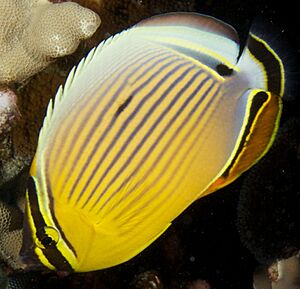Oval butterflyfish facts for kids
Quick facts for kids Oval butterflyfish |
|
|---|---|
 |
|
| Conservation status | |
| Scientific classification | |
| Genus: |
Chaetodon
|
| Species: |
lunulatus
|
The oval butterflyfish (Chaetodon lunulatus) is also known as the red-finned butterflyfish or redfin butterflyfish. It's a type of ray-finned fish that lives in the ocean. This beautiful fish belongs to the family called Chaetodontidae, which are known as butterflyfishes. You can find the oval butterflyfish swimming in the Pacific Ocean, all the way from Eastern Indonesia to the Hawaiian islands. It's part of a group of very similar fish. This group includes the blacktail butterflyfish, which lives in the Red Sea, and the melon butterflyfish, found in the Indian Ocean.
Contents
What Does the Oval Butterflyfish Look Like?
The oval butterflyfish (C. lunulatus) looks a lot like its relatives, the blacktail butterflyfish (C. austriacus) and the melon butterflyfish (C. trifasciatus). They all have similar colors. However, the blacktail butterflyfish has black tail and anal fins. The melon butterflyfish, which lives in the Indian Ocean, has a clearer dark spot below its dorsal fin and a mostly yellow anal fin.
The oval butterflyfish can grow up to about 14 centimeters (5.5 inches) long. It has around 13 to 14 spines on its back fin (dorsal fin). It also has 20 to 22 soft rays on its dorsal fin. On its anal fin, it has three spines and 18 to 21 soft rays.
Scientists group the oval butterflyfish with the black-tailed and melon butterflyfishes. They also include the Arabian butterflyfish (C. melapterus) in this group. These fish are part of a smaller group called Corallochaetodon.
Where Do Oval Butterflyfish Live?
Oval butterflyfish live in the Pacific Ocean. Their range stretches from Japan and Australia in the north and south. To the east, they can be found near Hawaii and the Tuamotu Islands. These fish live near the bottom of the ocean, but also swim in the open water. They prefer tropical coral reefs.
You can find them at depths of 3 to 30 meters (about 10 to 100 feet). They like lagoons and reefs that are rich in coral and somewhat protected from strong currents. Young oval butterflyfish are quite shy. They like to hide among the corals to stay safe.
How Do Oval Butterflyfish Live?
What Do Oval Butterflyfish Eat?
The oval butterflyfish is a picky eater! It eats almost only hard corals. This fish is known to eat many different types of coral. Studies have shown it feeds on 51 different kinds of coral. Some of its favorite meals include Acropora florida, A. gemmifera, A. hyacinthus, A. intermedia, and Pocillopora damicornis.
How Coral Bleaching Affects Them
Coral bleaching is a big problem for the oval butterflyfish. Coral bleaching happens when corals get stressed and turn white, often because the water gets too warm. A study in 2004 found that the oval butterflyfish became less healthy right after a coral bleaching event. This could mean fewer fish survive.
Another study in 2006 looked at the Great Barrier Reef. It found that many butterflyfish species, including the oval butterflyfish, decreased in number after bleaching. Only the butterflyfishes that only eat coral, like the oval butterflyfish, showed this decline. Fish that eat other things or don't eat coral were not affected as much. This suggests that the oval butterflyfish might have starved because there wasn't enough coral for them to eat.
Reproduction and Mating
Oval butterflyfish lay eggs, which means they are oviparous. It's hard to tell the difference between male and female fish just by looking at them. Both male and female fish can live alone or form pairs.
Studies show that male and female fish often form pairs. This pairing helps them with reproduction. Once they find a partner, they tend to stay together for a long time. One study even reported that some pairs stayed together for up to seven years! In these pairs, the female fish eats more often. The male fish usually swims in front when they are together. These pairs swim very close to each other, often side-by-side. They almost always stay within about 4 meters (13 feet) of each other.
How Oval Butterflyfish Defend Their Space
Butterflyfish like to protect their own areas from other fish of the same kind. A common way they show they are upset is by doing a "tail-up display." They do this when they are fighting over territory. They also do it in friendly interactions with their partner.
If another fish doesn't do the tail-up display, the oval butterflyfish might attack it. When they are fighting over territory, they show different behaviors. These include circling each other, staring, doing the tail-up display, and even fighting by piling on top of each other. They also swim side-by-side, chase, rush, flee, and attack. However, deadly fights only happen when they are trying to find a mate. They don't fight to the death over things like shelter or food.


